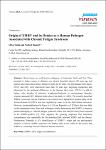Origin of XMRV and its Demise as a Human Pathogen Associated with Chronic Fatigue Syndrome
Hohn, Oliver
Bannert, Norbert
Retroviruses are well known pathogens of mammals, birds and fish. Their potential to induce cancer in chickens was already described almost 100 years ago and murine retroviruses have been a subject of study for 50 years. The first human retroviruses, HTLV and HIV, were discovered more than 30 years ago, surprising researchers and physicians by the profound differences in the diseases they cause. HTLV-1 is able to induce, after decades of infection, lymphomas/leukemia or neuroimmune disorders whereas untreated HIV infection leads almost inevitably to AIDS. The recently described XMRV (xenotropic murine leukemia virus-related virus) appeared to possess many of the features known for HTLV and was regarded by some to be the third human retrovirus. However, recent publications by Knox et al. [1] and Paprotka et al. [2] have shed new light on this gammaretrovirus. Knox and colleagues clearly demonstrate that XMRV is absent in patients belonging to a chronic fatigue syndrome cohort who had previously been reported to be XMRV-positive [3]. This supports the growing suspicion that laboratory contamination was responsible for the postulated link between XMRV and the disease. Furthermore, Paprotka et al’s identification of XMRV’s origin and the phylogenetic analysis of known XMRV sequences are further nails in the coffin to the notion that XMRV is a clinically relevant infectious human retrovirus.
No license information

